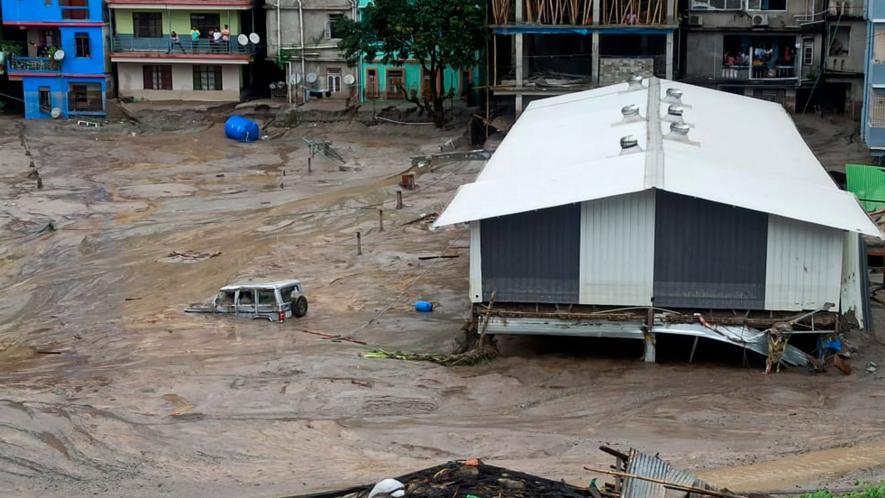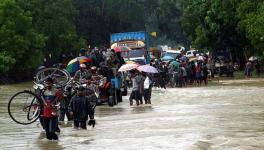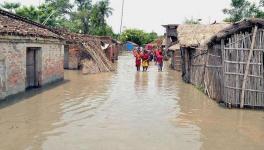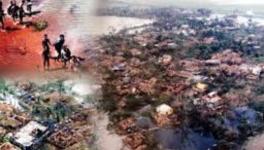Climate Change Caused Devastating South Lhonk Glacial Lake Outburst Flood in Sikkim, Says Study

PTI file photo of the 2023 floods in Sikkim.
Patna/Kathmandu: For the first time since devastating South Lhonk Glacial Lake Outburst Flood (GLOF) in Sikkim in 2023, a scientific study has revealed climate change as the cause. Scientists had warned in 2021 that the South Lhonak lake in Sikkim would burst, as per reports. They had repeatedly said that climate change was causing an impact on Himalayan glaciers and glacial lakes.
According to the research published in Science magazine, GLOFs occur when lakes fed by melting glaciers release large volumes of water due to dam failures triggered by glacier calving, heavy rainfall,
avalanche. These events pose increasing threats to mountain communities, as climate change accelerates glacial retreat and destabilises moraine dams.
“The South Lhonak GLOF serves as a grim reminder for similar high-risk lakes across the region,” said Ashim Sattar, Assistant Professor at Indian Institute of Technology (IIT), Bhubaneshwar, and lead author of the study. “We urgently need a multi-faceted approach, including early warning systems, strengthened regulatory frameworks, and community education, to mitigate these risks.”
The research, led by a team of international scientists from nine countries, including Kathmandu-based International Centre for Integrated Mountain Development (ICIMOD), examines the triggers, dynamics, and cascading impacts of the flood, offering critical insight for Himalayan communities vulnerable to climate-induced disasters.
“This research paper exemplifies global collaboration among Earth scientists, using cutting-edge satellite imagery and modelling techniques to unravel the complexities of cryospheric hazards,” said Mohd. Farooq Azam, Intervention Manager, Cryosphere, ICIMOD, and a co-author of the study.
The report highlighted the future risks of such climate induced disasters in the Himalyas. South Lhonak Lake remains highly susceptible to future GLOF due to altered slope geometry, with small-scale mass movements already visible on the failure slope.
The study is a significant contribution to the growing body of research on climate change-driven cryosphere hazards. It provides crucial insights for policymakers, disaster response agencies and researchers to safeguard vulnerable mountain communities.
“This study reveals how climate change is amplifying glacial hazards, with the 2023 Sikkim GLOF triggering an unprecedented cascade of destruction. It underscores the urgent need for better early warning systems, resilient infrastructure, stronger regional cooperation to mitigate future risks, and, most of all, faster action to switch to renewable energy especially among high emitting economies,” said Arun Shrestha, Senior Climate Change Specialist, ICIMOD.
The GLOF disaster in Sikkim resulted in 55 casualties, with 70 people still missing and caused extensive damage to critical infrastructure including hydropower facilities, bridges, highways, and buildings in the Teesta Valley. This event ranks among the most catastrophic GLOFs to hit the Himalaya in recent decades.
The scientists used high-resolution satellite imagery and modelling techniques for the study that reveals that the GLOF was triggered by a collapse of up to 14.7 million cubic meters of frozen moraine material into the South Lhonak Lake. This collapse generated a tsunami-like wave approximately 20 meters high, which eroded the lake’s frontal moraine dam, releasing about 50 million cubic meters of water – equivalent to 20,000 Olympic-sized swimming pools.
The flood severely impacted settlements and infrastructure along the Teesta River, breaching the Teesta III dam in Chunthang district. The study highlights the role of cascading hazards, where initial flooding triggered secondary landslides and debris flows, compounding the destruction.
The study recommended enhanced Early Warning Systems. There is urgent need of implementation of improved hazard detection and response systems across the Himalaya and advanced GLOF modelling, it said, adding that current models often underestimate risks by failing to account for sediment entrainment and riverbank collapses.
It said the recent disaster shows the need for urgent, adaptive plans, particular for basin-scale early warning systems and strengthening regulations and risk assessments for hydropower projects near
glacier lakes to safeguard communities.
In 2020, ICIMOD’s research report had identified as many as 47 potentially dangerous glacial lakes (PDGLs) in Koshi, Gandaki, and Karnali river basins of Nepal, Tibet Autonomous Region of China, and India. These glacial lakes are at risk of breaching their natural dams, which will result in GLOFs.
According to the report released early this week, GLOFs are a prominent water-induced hazard in Nepal and other mountainous countries in the Hindu Kush Himalaya (HKH) region, and occur when melting glaciers create reservoirs of water that can suddenly burst leading to floods downstream.
The writer is a freelancer based in Patna, Bihar.
Get the latest reports & analysis with people's perspective on Protests, movements & deep analytical videos, discussions of the current affairs in your Telegram app. Subscribe to NewsClick's Telegram channel & get Real-Time updates on stories, as they get published on our website.























